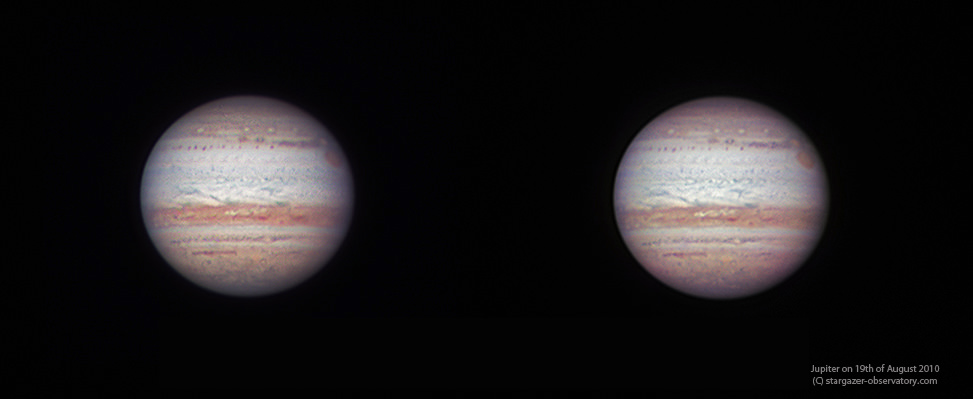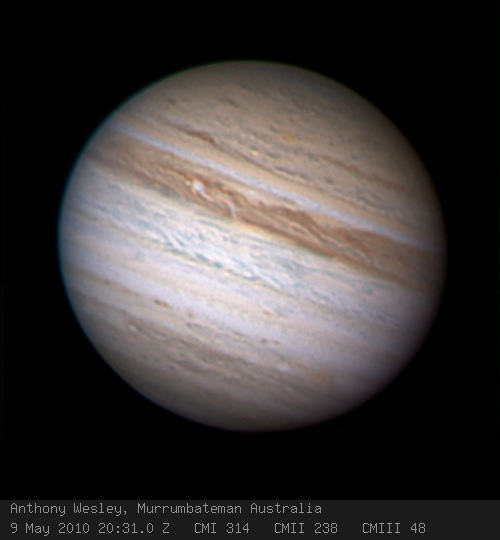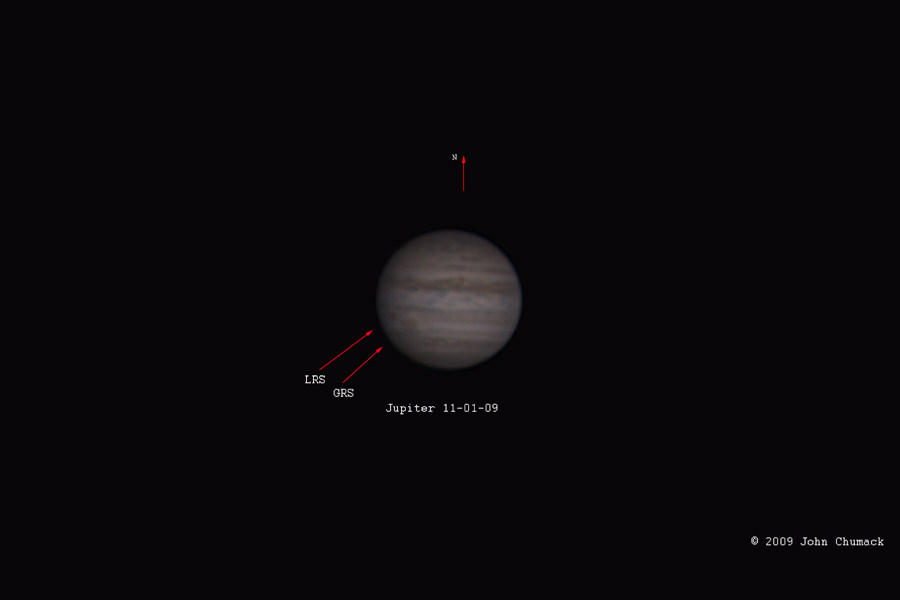It looks like once again, Jupiter has taken a hit! And once again an amateur astronomer spotted and captured the event. Masayuki Tachikawa was observing Jupiter on at 18:22 Universal Time on August 20th (early on August 21 in Japan) and his video camera captured a 1-second-long flash on the planet’s disk, along the northern edge of the gas giant’s North Equatorial Belt. The event was reported by astronomer Junichi Watanabe from the National Astronomical Observatory of Japan, on his blog.
Continue reading “Jupiter Gets Smacked Yet Again?”
Observing Spotlight – Dropping In On Jupiter…
[/caption]
“Now that she’s back in the atmosphere, with drops of Jupiter in her hair…” Oh! Hey, there! Come on over and have a seat. Yeah, I really like that “Train” song, too. While the Moon is putting the brakes on deep sky observing, why don’t you take a look though the magnificent eye of the 9″ TMB refractor of Dietmar Hager and we world-wide friends can spend a little quality time together with Jupiter.
Here… You look through the eyepiece of a little telescope for awhile and I’ll tell you some of the things we know about this giant planet.
What’s that you say? Yes. Jupiter is big… Big enough to hold the mass of 1,000 Earths and about 1/10 the size of our Sun. Its a heavy-weight, too… But, believe it or not, Jupiter’s density is only about 1/4 of that of Earth’s. Scientists think this means the giant planet consists mostly of hydrogen and helium around a core of heavy elements. That means Jupiter more closely resembles a sun instead of a planet! Yeah… It’s hot there, too. As a matter of fact, Jupiter is putting out twice as much heat as it receives from Sol. Near the core temperature may be about 43,000 degrees F (24,000 degrees C)… Even hotter than the surface of the Sun. Hot enough to get a burn? Darn right. Those subtle tones of red and brown are chemical reactions much like what happens when we humans get a sunburn.
I see you smiling in the dark. Are you starting to notice details Jupiter’s cloud bands? Even a small telescope shows these areas called “zones”. This is where chemicals have formed colorful layers of clouds at different heights. The white belts are made of crystals of frozen ammonia and they are positioned much higher than the dark belts. Of course, you know all about the “Great Red Spot”, but sometimes it’s pretty hard to see unless you know when to look. Jupiter makes a complete rotation in about 10 hours, so even if you can’t see something right now – you can wait awhile and it will come around.
Speaking of coming around, did you notice how close one of Jupiter’s moon is getting to the edge of the planet? Then keep watching because we’re about to see a transit happen. Jupiter has at least 60 moons, but 4 of them are bright and very easy to see even in binoculars. They were discovered by Galileo, and that’s why you’ll sometimes hear them called the “galiean moons”. When they zip around behind Jupiter in their orbit, it’s called a occultation – but when they go in front of the planet from our point of view, it’s called a tranist. The really fun part is that you can not only see the little moon going across the surface, but a few minutes later? You can see the shadow, too! Here’s a little bit of magic from another friend of ours named Sander Klieverik.

Isn’t that just the coolest? You’re going to be hearing a lot about Sander’s work here in the near future. And there’s going to be a great Jupiter event he wants to make sure you know about!
“On October 31, 2010 Europa and Ganymede will simultaneously cross the cloud tops of Jupiter from 02:26 till 03:21 UT as do their shadows from 04:17 UT till 07:00 UT. Timing of entrance of the first moon, Ganymede will be around 00.20 UT, following by Europe at 02:26 UT. The first shadow will appear 04:09, quickly followed by Europe’s shadow at 04:16. Two shadows in very close proximity should be a very beautiful view! Circumstances are favourable as Jupiter has a visual diameter of around 48 arc seconds, being a month after opposition in which Jupiter reached almost 50 arc seconds (minimum 33″). For the non-astronomers, when a planet is in opposition it is roughly closest to the Earth at this point of its orbit, making it appear bigger and brighter. At that moment it is visible almost all night, rising around sunset, culminating around midnight and setting around sunrise.”
In the meantime, why don’t you keep practicing timing galiean events and seeing them? Here’s a handy Jupiter Moon Tool, and Sander has also prepared a Jupiter Almanac as well!
“But tell me, did the wind sweep you off your feet? Did you finally get the chance to dance along the light of day… And head back to the Milky Way? And tell me, did Venus blow your mind? Was it everything you wanted to find? And did you miss me 1hile you were looking for yourself out there?”
Now, quit bogarting that eyepiece… It’s my turn!
Many thanks to the one and only Dietmar Hager, Jupiter Video courtesy of Northern Galactic and the up and coming Sander Klieverik’s “AstronomyLive”. Song lyrics – “Drops of Jupiter” are from the artists “Train”. Let’s keep on rockin’ the night!
Hubble Delves into Two Recent Jupiter Mysteries
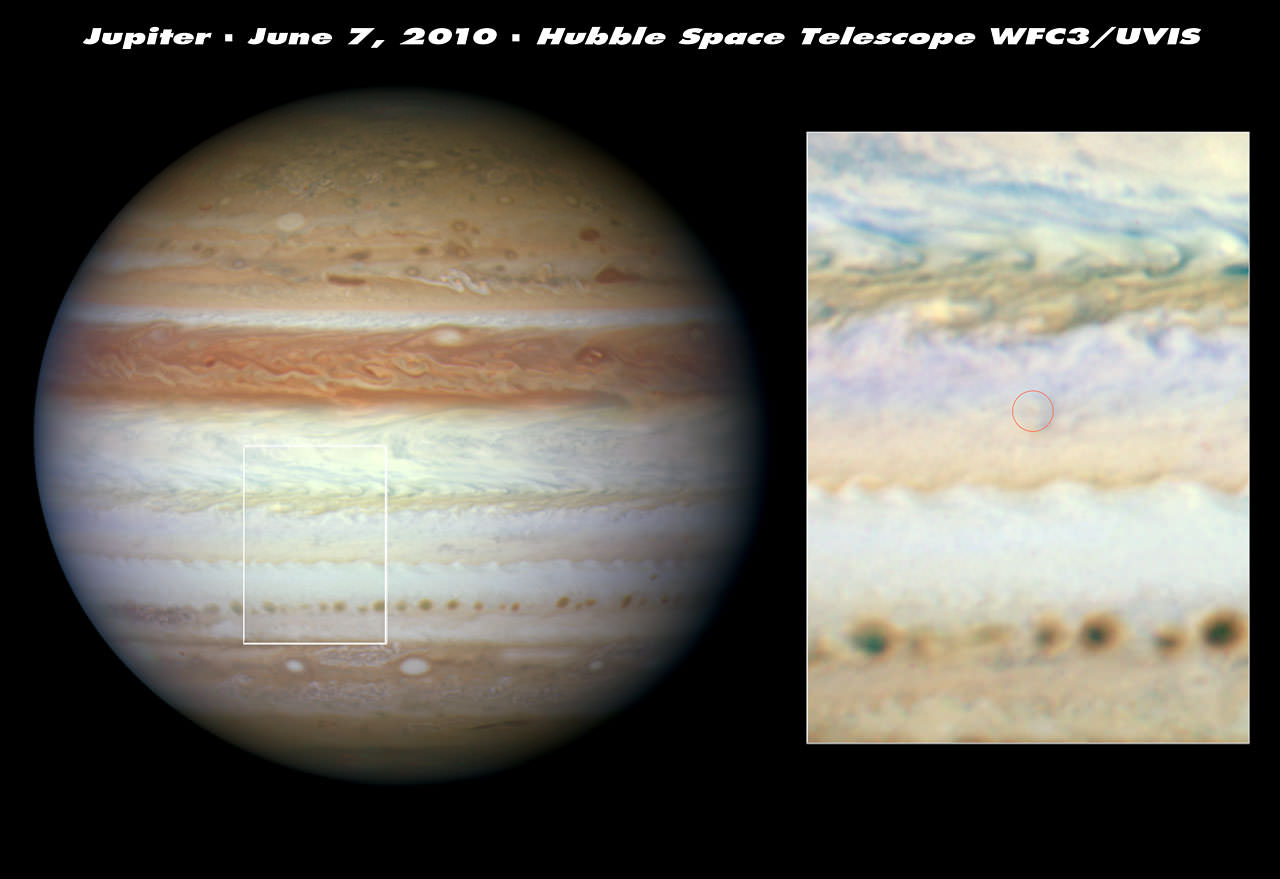
[/caption]
Jupiter has a few mysteries these days. Between an equatorial belt that has gone missing and an impact that didn’t leave a mark, astronomers decided they needed to put the Hubble Space Telescope on the case. New and detailed observations from the venerable space telescope have provided some insights into these two recent puzzling events.
At 22:31 (CEST) on June 3, 2010 Australian amateur astronomer Anthony Wesley saw a two-second-long flash of light on the disc of Jupiter, captured from a live video feed from his telescope. In the Philippines, amateur astronomer Chris Go confirmed that he had simultaneously recorded the transitory event on video. Wesley was also the discoverer of the now world-famous July 2009 impact.
Astronomers around the world suspected that something significant must have hit the giant planet to unleash a flash of energy bright enough to be seen here on Earth, about 770 million kilometers away. But they didn’t know how just how big it was or how deeply it had penetrated into the atmosphere. Over the past two weeks there have been ongoing searches for the “black-eye” pattern of a deep direct hit like those left by former impactors.
Astronomers turned Hubble’s Wide Field Camera 3 aboard the NASA/ESA Hubble Space Telescope on June 7, and found no sign of debris above Jupiter’s cloud tops. This means that the object didn’t descend beneath the clouds and explode as a fireball. If it had, then dark sooty blast debris would have been ejected and would have rained down onto the clouds.
Instead the flash is thought to have come from a giant meteor burning up high above Jupiter’s cloud tops, which did not plunge deep enough into the atmosphere to explode and leave behind any telltale cloud of debris, as seen in previous Jupiter collisions.
“The cloud tops and the impact site would have appeared dark in the ultraviolet and visible images due to debris from an explosion,” said team member Heidi Hammel of the Space Science Institute in Boulder, Colorado. “We can see no feature that has those distinguishing characteristics in the known vicinity of the impact, suggesting there was no major explosion and no ‘fireball’.”
Dark smudges marred Jupiter’s atmosphere when a series of fragments of Comet Shoemaker-Levy 9 hit Jupiter in July 1994, and a similar dark area formed in July 2009 when a suspected asteroid slammed into Jupiter. The latest intruder is estimated to be only a fraction of the size of these previous impactors and is thought to have been a meteor.
So, Wesley and Go were fortunate to have spotted the flash.
“Observations of these impacts provide a window on the past — onto the processes that shaped our Solar System in its early history,” said team member Leigh Fletcher of the University of Oxford, UK. “Comparing the two collisions — from 2009 and 2010 — will hopefully yield insights into the types of impact processes in the outer Solar System, and the physical and chemical response of Jupiter’s atmosphere to these amazing events.”

Since Hubble was now trained on Jupiter, astronomers used the opportunity to get a close-up look at changes in Jupiter’s atmosphere following the disappearance of the dark cloud feature known as the Southern Equatorial Belt several months ago.
In the Hubble view, a slightly higher altitude layer of white ammonia ice crystal clouds appears to obscure the deeper, darker belt clouds. “Weather forecast for Jupiter’s Southern Equatorial Belt: cloudy with a chance of ammonia,” Hammel said.
The team predicts that these ammonia clouds should clear out in a few months, as they have done in the past. The clearing of the ammonia cloud layer should begin with a number of dark spots like those seen by Hubble along the boundary of the south tropical zone.
“The Hubble images tell us these spots are holes resulting from localized downdrafts. We often see these types of holes when a change is about to occur,” said Amy Simon-Miller from Goddard Space Flight Center. .
“The Southern Equatorial Belt last faded in the early 1970s. We haven’t been able to study this phenomenon at this level of detail before,” Simon-Miller added. “The changes of the last few years are adding to an extraordinary database on dramatic cloud changes on Jupiter.”
Source: ESA’s Hubble website
New Impact on Jupiter
[/caption]
In an incredible coincidence where a paper was released today about the 2009 impact event on Jupiter, the same amateur astronomer who captured that event also captured a new impact Jupiter that occurred at about 20:30 UT today (June 3, 2010). Anthony Wesley from Australia captured the flash of an impact, which was also captured and confirmed by Christopher Go of the Philippines. Watch Go’s video here. Go said he shot it with a blue filter. Word is that Anthony is processing his video, and we’ll post it when available.
Update: We’ve added Anthony Wesley’s color image of the impact, above (you can see the original image below) and also added Anthony’s video of the event, below.
And here’s a direct link to Anthony Wesley’s video (mwv) of the impact.
Here’s Anthony’s original greyscale image:

New Hubble Images Zoom In on Asteroid Impact on Jupiter
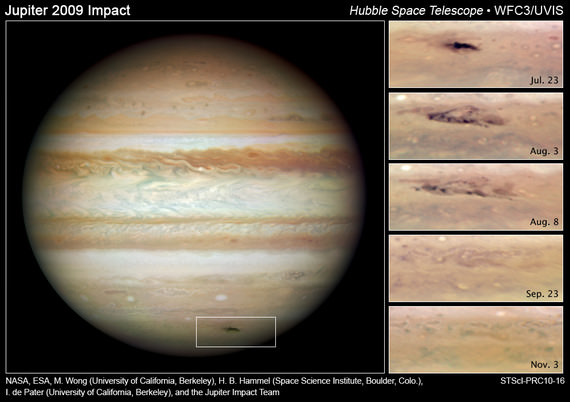
[/caption]
When amateur astronomer Anthony Wesley from Australia saw a dark spot the size of the Pacific Ocean appear on Jupiter through his telescope on July 19, 2009, this started a flurry of astronomic activity, with other telescopes quickly slewing to take a look. It didn’t take long for other astronomers to confirm Jupiter had been hit by an object, either an asteroid or a comet. Of course, the world’s most famous telescope, Hubble, zeroed in on this unexpected activity on Jupiter, and luckily, the telescope had been recently updated with a new Wide Field Camera 3 and newly repaired Advanced Camera for Surveys. Astronomers have now released a series of images from Hubble which may show for the first time the immediate aftermath of an asteroid striking another planet.
Astronomers have witnessed this kind of cosmic event before, but from a comet. Similar scars had been left behind during the course of a week in July 1994, when more than 20 pieces of Comet P/Shoemaker-Levy 9 (SL9) plunged into Jupiter’s atmosphere. The 2009 impact occurred during the same week, 15 years later.
But comparing Hubble images of both collisions, astronomers say the culprit was likely an asteroid about 1,600 feet (500 meters) wide.

Source: Hubblesite.org
“This solitary event caught us by surprise, and we can only see the aftermath of the impact, but fortunately we do have the 1994 Hubble observations that captured the full range of impact phenomena, including the nature of the objects from pre-impact observations” says astronomer Heidi Hammel of the Space Science Institute in Boulder, Colo., leader of the Jupiter impact study.
The analysis revealed key differences between the two collisions (in 1994 and 2009), providing clues to the 2009 event. Astronomers saw a distinct halo around the 1994 impact sites in Hubble ultraviolet (UV) images, evidence of fine dust arising from a comet-fragment strike. The UV images also showed a strong contrast between impact-generated debris and Jupiter’s clouds.
Hubble ultraviolet images of the 2009 impact showed no halo and also revealed that the site’s contrast faded rapidly. Both clues suggest a lack of lightweight particles, providing circumstantial evidence for an impact by a solid asteroid rather than a dusty comet.
The elongated shape of the recent asteroid impact site also differs from the 1994 strike, indicating that the 2009 object descended from a shallower angle than the SL9 fragments. The 2009 body also came from a different direction than the SL9 pieces.

Source: Hubblesite.org
Team member Agustin Sanchez-Lavega of the University of the Basque Country in Bilbao, Spain, and colleagues performed an analysis of possible orbits that the 2009 impacting body could have taken to collide with Jupiter. Their work indicates the object probably came from the Hilda family of bodies, a secondary asteroid belt consisting of more than 1,100 asteroids orbiting near Jupiter.
The 2009 strike was equal to a few thousand standard nuclear bombs exploding, comparable to the blasts from the medium-sized fragments of SL9. The largest of those fragments created explosions that were many times more powerful than the world’s entire nuclear arsenal blowing up at once.
The recent impact underscores the important work performed by amateur astronomers. “This event beautifully illustrates how amateur and professional astronomers can work together,” said Hammel.
The Jupiter bombardments reveal that the solar system is a rambunctious place, where unpredictable events may occur more frequently than first thought. Jupiter impacts were expected to occur every few hundred to few thousand years. Although there are surveys to catalogue asteroids, many small bodies may still go unnoticed and show up anytime to wreak havoc.
The study by Hammel’s team appeared in the June 1 issue of The Astrophysical Journal Letters.
Science Paper by: Hammel et al. (PDF document)
Source: HubbleSite
Jupiter, It Is A-Changing
[/caption]
Jupiter’s appearance has changed dramatically since the end of 2009, when it moved too close to the Sun from our vantage point on Earth to be observed. New looks at the planet after it emerged from the Sun’s glare reveals that one of the bands of clouds, the South Equatorial Belt, has gone missing. This image from amateur astronomer Anthony Wesley (the same astronomer who captured an impact spot on Jupiter last year) taken on May 9, 2010, shows a rather undressed Jupiter without its usually prominent southern band. See a comparison of earlier images below.
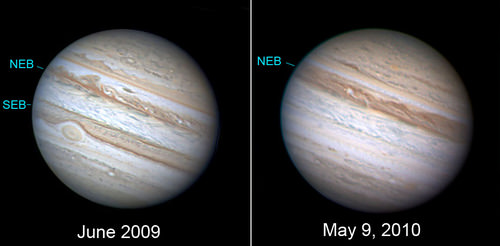
What caused the disappearance of the band? Astronomers aren’t sure, but this isn’t the first time this has happened. Back in 1973 when the Pioneer 10 spacecraft flew by and took the first close-up images of the planet, the southern band was missing, and it also disappeared in the early 1990s. Also, in 2007 cloud bands around its equator that had been light-colored for the past 15 years or so were noticeably darker.
Emily at the Planetary Society has written about this, and so has amateur astronomer Bob King, a.k.a “Astro Bob,” who explains:
“Every 3-15 years, the belt, which is normally dark reddish-brown in color and typically divided in two by the south equatorial belt zone, fades from view. After some weeks or months a brilliant white spot forms within that zone and begins spouting dark blobs of material which get stretched into filaments and ovals by Jupiter’s fierce winds into a new SEB. Within a few weeks (or longer) the belt is back and Jupiter presents its familiar dual “tire track” appearance through a telescope.”
Check out Anthony Wesley’s gallery of Jupiter images, and watch for new images over the next days and months to monitor the changes. Surely, Hubble and other observatories will be making new observations, as well.
Thanks to Anthony Wesley for sharing his images.
New Images Unlock Secrets of Jupiter’s Red Spot

It’s difficult enough to track the weather on Earth, but with new thermal images of Jupiter’s Great Red Spot, scientists now have the first detailed interior weather map of a giant storm system on another planet. “This is our first detailed look inside the biggest storm of the solar system,” said Glenn Orton, a senior research scientist at NASA’s Jet Propulsion Laboratory. “We once thought the Great Red Spot was a plain old oval without much structure, but these new results show that it is, in fact, extremely complicated.”
Continue reading “New Images Unlock Secrets of Jupiter’s Red Spot”
One of Jupiter’s Moons is Melted!

[/caption]
Jupiter’s two moons Ganymede and Callisto could be considered fraternal twins. They have a similar composition and size, but visually, they are different. Also, data from the Galileo and Voyager spacecraft reveal the two moons’ interiors are very dissimilar, as well. The reasons for the differences have eluded scientists for 30 years, but a new study provides an explanation. During the Late Heavy Bombardment, Callisto escaped relatively unscathed, while Ganymede was a battered child; so much so that the later moon melted. “Impacts during this period melted Ganymede so thoroughly and deeply that the heat could not be quickly removed,” said Dr. Amy Barr of the Southwest Research Institute. “All of Ganymede’s rock sank to its center the same way that all the chocolate chips sink to the bottom of a melted carton of ice cream. Callisto received fewer impacts at lower velocities and avoided complete melting.”
Barr and and Dr. Robin Canup created a model showing how Jupiter’s strong gravity focused cometary impactors onto Ganymede and Callisto 3.8 billion years ago, during the LHB period. Each impact onto Ganymede or Callisto’s mixed ice and rock surface creates a pool of liquid water, allowing rock in the melt pool to sink to the moon’s center.
But Ganymede is closer to Jupiter and therefore was hit by twice as many icy impactors as Callisto. Additionally, the impactors hitting Ganymede had a higher average velocity. Modeling by Barr and Canup shows that core formation begun during the late heavy bombardment becomes energetically self-sustaining in Ganymede but not Callisto.

Watch a movie that shows the effect of an outer solar system late heavy bombardment on the interior structure of Callisto (top model in the movie) and Ganymede (bottom).
“Similar to Earth and Venus, Ganymede and Callisto are twins, and understanding how they were born the same and grew up to be so different is of tremendous interest to planetary scientists,” explains Barr. “Our study shows that Ganymede and Callisto record the fingerprints of the early evolution of the solar system, which is very exciting and not at all expected.”
The “Ganymede-Callisto dichotomy,” has been a classical problem in comparative planetology, a field of study that seeks to explain why some solar system objects with similar bulk characteristics have radically different appearances. The study by Barr and Canup also links the evolution of Jupiter’s moons to the orbital migration of the outer planets and the bombardment history of Earth’s moon.
Source: SwRI
Jupiter – Our Silent Guardian?
[/caption]
We live in a cosmic shooting gallery. In Phil Plait’s Death From the Skies, he lays out the dangers of a massive impact: destructive shockwaves, tsunamis, flash fires, atmospheric darkening…. The scenario isn’t pretty should a big one come our way. Fortunately, we may have a silent guardian: Jupiter.
Although many astronomers have assumed that Jupiter would likely sweep out dangerous interlopers (an important feat if we want life to gain a toehold), little work has been done to actually test the idea. To explore the hypothesis, a recent series of papers by J. Horner and B. W. Jones explores the effects of Jupiter’s gravitational pull on three different types of objects: main belt asteroids (which orbit between Mars and Jupiter), short period comets, and in their newest publication, submitted to the International Journal of Astrobiology, the Oort cloud comets (long period comets with the most distant part of their orbits far out in the solar system). In each paper, they simulated the primitive solar systems with the bodies in question with an Earth like planet, and gas giants of varying masses to determine the effect on the impact rate.
Somewhat surprisingly, for main belt asteroids, they determined, “that the notion that any ‘Jupiter’ would provide more shielding than no ‘Jupiter’ at all is incorrect.” Even without the simulation, the astronomers say that this should be expected and explain it by noting that, although Jupiter may shepherd some asteroids, it is also the main gravitational force perturbing their orbits and causing them to move into the inner solar system, where they may collide with Earth.
Contrary to the popular wisdom (which expected that the more massive the planet, the better it would shield us), there were notably fewer asteroids pushed into our line of sight for lower masses of the test Jupiter. Also surprisingly, they found that the most dangerous scenario was an instance in which the test Jupiter had 20% in which the planet “is massive enough to efficiently inject objects to Earth-crossing orbits.” However, they note that this 20% mass is dependent on how they chose to model the primordial asteroid belt and would likely change had they chosen a different model.
When the simulation was redone for for short period comets, they again found that, although Jupiter (and the other gas giants) may be effective at removing these dangerous objects, quite often they did so by sending them our way. As such, they again concluded that, as with asteroids, Jupiter’s gravitational jiggling was more dangerous than it was helpful.
Their most recent treatise explored Oort cloud objects. These objects are generally considered the largest potential threat since they normally reside so far out in the solar system’s gravitational well and thus, will have a greater distance to fall in and pick up momentum. From this situation, the researchers determined that the more massive the planet in Jupiter’s orbit, the better it does protect us from Oort cloud comets. The attribute this to the fact that these objects are initially so far from the Sun, that they are scarcely bound to the solar system. Even a little bit of extra momentum gained if they swing by Jupiter will likely be sufficient to eject them from the solar system all together, preventing them from settling into a closed orbit that would endanger the Earth every time it passed.
So whether or not Jupiter truly defends us or surreptitiously nudges danger our way depends on the type of object. For asteroids and short period comets, Jupiter’s gravitational agitation shoves more our direction, but for the ones that would potentially hurt is the most, the long period comets, Jupiter does provide some relief.
Jupiter’s Dueling Red Spots
Even though most of us have been suffering from poor seeing conditions due to both hemisphere’s seasonal climate changes, the changes we’re experiencing look like nothing compared to what’s happening on Jupiter. If you think we’ve got turbulent atmosphere and more than our fair share of clouds – then check out what John Chumack’s been watching!
“I captured Jupiter last night (7:45pm EST on 11-01-09) from my backyard in Dayton, but the seeing was rather poor….but I did notice that the Great Red Spot had Company…the Little Red Spot has gotten noticeably redder and is now very close to the GRS.”
Of course, we all know the Great Red Spot is a great anti-cyclonic (high pressure) storm similar to our terrestrial hurricanes, but it is enormous. Three Earths would fit within its boundaries! And we also know this huge storm has persisted for at least the 400 years that we humans have observed it through telescopes. But in all that time, has it ever collided with another storm front?
Because the GRS can never occur over a land mass and the fact that it is driven by Jupiter’s internal heat source may be why it has hung around for so long. Thanks to some far reaching computer simulations, astronomers believe such large disturbances may be a stable feature of Jupiter, and that stronger disturbances tend to absorb weaker ones. Has the GRS consumed smaller anti-cyclones in its past and that is why is is so big? Is it about to do it again?
Since the cometary collision that created the “Great Black Spot” in July of this year occurred, many observers and photographers have been keeping an eye on Jupiter’s activity. Says John, “Since July they seem to have been getting closer together and may eventually collide….it will be fun watching to see which one survives the duel!!!”
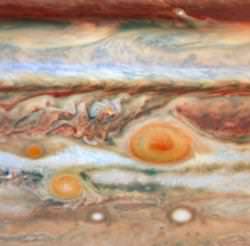 In 2006, Oval BA, also known as “Red Jr.,” sideswiped its huge companion – just as it does about every two years. Chances are good that when the two meet, the smaller of the pair will end up losing its ruddy tones – the larger storm slowing Oval BA’s spin and possibly reversing the process that reddened it in the first place. Will it pull up even more material from below Jupiter’s surface? Or will it disperse what’s already there? No one knows for sure… But what we do know is that when a third “Red Spot” passed between the two in 2008… and it didn’t survive the interaction. Need to know when to watch? Then take this:
In 2006, Oval BA, also known as “Red Jr.,” sideswiped its huge companion – just as it does about every two years. Chances are good that when the two meet, the smaller of the pair will end up losing its ruddy tones – the larger storm slowing Oval BA’s spin and possibly reversing the process that reddened it in the first place. Will it pull up even more material from below Jupiter’s surface? Or will it disperse what’s already there? No one knows for sure… But what we do know is that when a third “Red Spot” passed between the two in 2008… and it didn’t survive the interaction. Need to know when to watch? Then take this:
Great Red Spot Transit Times (UT):
November 1: 5:36, 15:31; 2: 1:27, 11:23, 21:19; 3: 7:14, 17:10; 4: 3:06, 13:02, 22:58; 5: 8:53, 18:49; 6: 4:45, 14:41; 7: 0:36, 10:32, 20:28; 8: 6:24, 16:20; 9: 2:15, 12:11, 22:07; 10: 8:03, 17:59; 11: 3:54, 13:50, 23:46; 12: 9:42, 19:38; 13: 5:33, 15:29; 14: 1:25, 11:21, 21:17; 15: 7:12, 17:08; 16: 3:04, 13:00, 22:56; 17: 8:51, 18:47; 18: 4:43, 14:39; 19: 0:35, 10:30, 20:26; 20: 6:22, 16:18; 21: 2:14, 12:10, 22:05; 22: 8:01, 17:57; 23: 3:53, 13:49, 23:44; 24: 9:40, 19:36; 25: 5:32, 15:28; 26: 1:23, 11:19, 21:15; 27: 7:11, 17:07; 28: 3:03, 12:58, 22:54; 29: 8:50, 18:46; 30: 4:42, 14:38
December 1: 0:33, 10:29, 20:25; 2: 6:21, 16:17; 3: 2:13, 12:08, 22:04; 4: 8:00, 17:56; 5: 3:52, 13:48, 23:43; 6: 9:39, 19:35; 7: 5:31, 15:27; 8: 1:22, 11:18, 21:14; 9: 7:10, 17:06; 10: 3:02, 12:58, 22:53; 11: 8:49, 18:45; 12: 4:41, 14:37; 13: 0:33, 10:28, 20:24; 14: 6:20, 16:16; 15: 2:12, 12:08, 22:03; 16: 7:59, 17:55; 17: 3:51, 13:47, 23:43; 18: 9:39, 19:34; 19: 5:30, 15:26; 20: 1:22, 11:18, 21:14; 21: 7:09, 17:05; 22: 3:01, 12:57, 22:53; 23: 8:49, 18:45; 24: 4:40, 14:36; 25: 0:32, 10:28, 20:24; 26: 6:20, 16:16; 27: 2:11, 12:07, 22:03; 28: 7:59, 17:55; 29: 3:51, 13:46, 23:42; 30: 9:38, 19:34; 31: 5:30, 15:26
And get thee out there with a telescope… Dueling Red Spots will be fun to watch!
Many thanks to John Chumack of Northern Galactic for sharing his image with us and to Sky & Telescope Magazine for the GRS transit prediction times!

